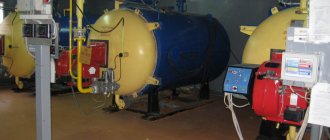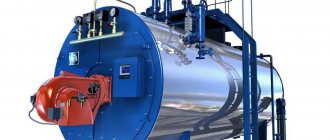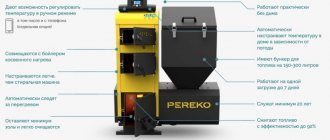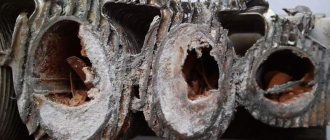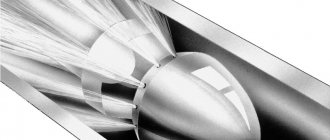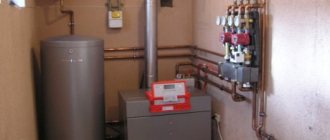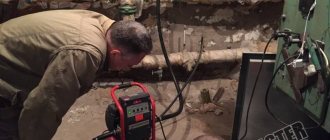Boiler flushing must be done thoroughly and systematically. Using hard water leads to the formation of scale and sediment. If the cleaning procedure is neglected, the boiler may fail ahead of schedule. To understand how pollution occurs, you can imagine an ordinary kettle that heats water several times every day. After some time, scale forms on the walls of the kettle, which leads to slower heating of the water. The same thing happens with the boiler.
Flushing the boiler from scale: consequences of ignoring
Modern mains use ordinary hard water, which quickly leads to the inside of the equipment being covered with scale. Boilers must be cleaned on a regular basis. If cleaning is not done on time. The consequences can be the most unpredictable, but definitely unpleasant.
If the boilers are not flushed from time to time, they will begin to overheat during operation.
The design of the gas boiler is such that the coolant coming from the return line cools the cavities of the heating elements located inside. The coolant cannot effectively cool the elements if they are covered with a thick layer of scale. If the boiler constantly overheats, it will soon stop working altogether.
What will happen if you ignore flushing?
- Scale consists of mineral deposits that do not promote thermal conductivity. Scale causes the water to heat up slowly, which requires significantly more electricity. A thick layer of scale leads to increased gas consumption, which increases the price of using the boiler.
- Scale can lead to boiler failure due to difficult coolant passage. This increases the load on the circulation pump, which leads to its rapid breakdown.
Before flushing the boiler, it is important to pay attention to what kind of liquid flows through the line. The need for frequent flushing will be due to very hard and contaminated water. In order to reduce the frequency of cleaning, it is necessary to use antifreeze - it is important that it is not expired.
Chemical cleaning of boilers
Devices and instruments
Acid is poured into the container using special equipment; boosters are most often used for this purpose. The devices consist of a container in which the reagent is placed and a pump that pumps it into the boiler. The equipment also has an electric heating device designed to increase the temperature of the reagent. It must be remembered that employees carrying out such boiler room maintenance must be equipped with protective clothing, rubber gloves and special glasses.
tcway.ru
Estimated cost of services
| from 1,000l to 2,500l cost 30,000₽-70,000₽ |
| from 2,500l to 5,000l cost 70,000₽ – 95,000₽ |
| from 2,500l to 5,000l cost 95,000₽ – 105,000₽ |
| from 5,000l to 10,000l cost90,000₽-180,000₽ |
| from 10,000l to 20,000l cost 155,000₽ – 300,000₽ |
| from 20,000l to 50,000l cost 270,000₽ – 800,000₽ |
The cost of work is determined based on the boiler model, location, heat exchange surface area, water volume and degree of contamination.
| from 1,000l to 2,500l cost 30,000₽-75,000₽ |
| from 2,500l to 5,000l cost 75,000₽ – 95,000₽ |
| from 2,500l to 5,000l cost 95,000₽ – 120,000₽ |
| from 5,000l to 10,000l cost 120,000₽-180,000₽ |
| from 10,000l to 20,000l cost 180,000₽ — 300,000₽ |
| from 20,000l to 50,000l cost 300,000₽ – 750,000₽ |
The cost of work is determined based on the boiler model, location, heat exchange surface area, water volume and degree of contamination.
| From 17,500 ₽ |
The cost of work is determined based on the heat exchanger model, location, heat exchange surface area, and water volume.
What explains the need to flush boiler and heat exchange equipment with chemical reagents?
In practice, the quality of water for heating networks does not meet established standards. Failure to comply with the regulations when putting the system into operation starts the process of deposition of excess salt and other impurities on the surface of the pipes. In this regard, the hydraulic regime is disrupted, the useful volume of the networks is reduced, which leads to a complete imbalance and threatens the integrity of the system. It is not possible to carry out mechanical cleaning of pipes and equipment due to the lack of technical potential, so chemical flushing becomes perhaps the only and most effective method of cleaning the system.
Stages of flushing boiler equipment:
1. Preliminary inspection of the internal surface and heating elements.2. Determination of the level of contamination and selection of chemical reagents.3. Direct flushing of boiler equipment under the strict supervision of specialists.
4. Drawing up a report on the work done.
Chemical washing of a boiler with a sludge level of more than 1500 g/m or with a content of silicic acid (sulfates) in deposits above 10% is carried out in two stages with preliminary alkalization before the acid stage. If the amount of sludge on the working surface of the boiler unit is more than 3000 - 4000 g/m, alternating acid and alkaline processing stages is required.
In certain cases, acid washing of the boiler should be preceded by mechanical (hydrodynamic) washing of sludge-filled areas, which allows to get rid of porous and uncemented deposits. In this case, the duration of cleaning and the amount of chemicals required for effective washing are significantly reduced.
Basic requirements for the chemical washing process: - use of safe detergents to avoid damage to the surfaces of the boiler unit;
— the ability to effectively remove deposits without the formation of insoluble compounds.
Flushing heat exchangers
Regular washing will not only increase the performance of the heat exchanger and reduce the risk of defects on working surfaces, but also prevent premature equipment failure. Chemical washing is necessary to clean the internal surfaces of the heat exchanger from harmful deposits that reduce the thermal conductivity of the system. Excessive contamination interferes with the productive operation of the heat exchanger and forces measures to be taken to artificially regulate the temperature regime. Regular flushing helps avoid unexpected accidents and damage to heat exchange equipment.
Chemical washing of the heat exchanger is carried out in several stages:
- Introduction into the heat exchanger of a solution with active substances, which, when reacting with deposits on the internal surfaces, break them down and remove them from the unit.
Washing the plates of heat exchange equipment with water to remove residual reagent. In case of ineffective flushing, active substances may react with the coolant, which will lead to equipment damage.
Examples of boiler surface contamination
Samples of extreme contaminants extracted from the water part of the boiler heating surfaces
Boiler water path - scale deposits before and after boiler flushing
Smoke pipes
Connection between flame tube and tube sheet
oooenerg.ru
Time to clean the boiler
Cleaning is done in three cases:
- For prevention. This type of boiler cleaning is carried out by the home owner once or twice a year. In this case, a minimum of money and effort is spent.
- When the heat exchanger is contaminated with scale or soot, its efficiency will be reduced. In this case, you can fix the problem yourself or call a technician.
- The heat generator has broken down. He just stops. In this case, you cannot do without a specialist. He gets the system working and flushes it.
Boiler flushing options
There are only three ways to flush a gas boiler for repair purposes:
- mechanical;
- hydraulic;
- complex.
The second and third methods are the most effective. If preventive or regular cleaning of the boiler can be done with your own hands, then it is better to entrust repairs to professionals.
The mechanical method involves using physical force and tools to remove scale from boilers. These can be scrapers or brushes, as well as modern spreading heads with various types of drive. Tools must be selected correctly and used with care. If the walls of the boiler are damaged, this will lead to increased corrosion, and then to rapid failure of the entire system. The least dangerous for the device is flushing using hydraulics. Pressurized water removes scale from all parts of the boiler.
With the complex option, boilers are washed using water pressure using tools. Most often this happens if there is too much contamination in some part of the device.
What is a heat exchanger
A gas boiler has an element in its design that is located above the firebox and consists of connected tubes. The coolant circulates in them. Its location is not accidental; combustion of gas in the boiler must heat the coolant, which is located in the heat exchanger.
The coolant is water. It heats up and passes further through the system. But untreated water contains many impurities that can settle in the tubes when heated. Most often these are salts and lime particles. If there is a lot of contamination, water has difficulty passing through the tubes, which leads to malfunctions.
Time to clean the heat exchanger
There are many contradictions about when it is necessary to flush the heat exchanger of a gas boiler. There are signs that will tell you that it's time for cleaning. The most important of them:
- a constantly switched on gas burner in the boiler;
- the circulation pump began to make noise, which indicates that it was overloaded;
- heating radiators take much longer to heat up;
- gas consumption has increased, although the boiler operating mode has not changed;
- the water pressure has weakened (pay attention to this sign when you need to flush a double-circuit boiler).
Procedure for flushing the heat exchanger with a booster
A booster is a special device for chemical cleaning. It allows the reagent solution to circulate autonomously in the heat exchanger.
- The first step is to disconnect both pipes of the device from the heating system.
- One of them is connected to the booster hose, through which the reagent will be supplied.
- The second pipe is also connected to the booster hose, but with a different one. The spent solution will come out into it. It turns out that the system will close and circulation will occur, and without additional participation.
- The spent solution will remain in the booster and must be drained. Rinse the heat exchanger with water.
It is better to clean with a booster several times, since the reagent gradually reduces its properties, and a new solution will increase the cleaning efficiency.
Methods for flushing the boiler and heat exchanger
Flushing the heat exchanger of a gas boiler is carried out to preserve the throughput of the device and its thermal qualities.
Devices may differ in the type of heat exchanger and the quality of the water used; depending on this, they should be washed in different ways. There are three reliable and proven methods:
- chemical;
- mechanical;
- combined.
Chemical method of washing the heat exchanger
Boilers are cleaned using reagents, mainly acids, and a special installation is required.
Using such an installation, the acid is dissolved to the desired consistency and heated. Temperature significantly affects the quality of washing. After preparing the solution, it is supplied to the heat exchanger and then removed.
Cleaning of heat exchangers occurs due to the presence and circulation of acid in it. Finish washing with plenty of water.
There is a possibility that the scale consists of various chemical components, so cleaning must be carried out using additional boiler flushing with other chemicals.
There are advantages to acid washing:
- there is no need to remove and disassemble the device, which significantly saves time;
- after such cleaning, the most common contaminants - hardness salts and magnesium hydroxide - will not remain in the heat exchanger.
There are also disadvantages:
- it is used for minor contamination;
- those contaminants that are formed due to corrosion cannot be removed by this method;
- safety measures are required, since the reagents are very toxic and dangerous;
- The solution after washing must be neutralized and disposed of.
Wash reagents
Manufacturers of various types of chemicals provide a choice of several options for means with which gas boilers are flushed.
Several parameters should be taken into account when choosing a particular product:
- pollution levels;
- the material from which the boiler and heat exchanger are made, their reaction to the purchased chemical.
The following substances are suitable for cleaning a home boiler:
- citric acid - its effectiveness in removing scale is very high;
- sulfamic and adipic acids - effective for preventive cleaning and regular washing, with light contamination;
- hydrochloric acid - this product is used to remove very severe contamination;
- various gels - they need to be dissolved in water (the effectiveness is in no way inferior to previous products).
Chemical washing of boilers and heat exchangers is carried out only in compliance with special safety measures.
Mechanical method of washing the heat exchanger
The main difference from the chemical method is the disassembly of the entire heat exchanger.
After this, each of the parts is washed separately with a stream of water under high pressure. This method is used in very rare cases when the contamination is not amenable to other types of cleaning.
Advantages:
- effective for severe contamination, even corrosion products can be washed only with this method;
- the use of chemicals is excluded - this is an absolutely safe method;
- no need for additional disposal of the washing solution.
Flaws:
- The main disadvantage of mechanical flushing remains the disassembly of the entire unit. This is very difficult to do, and some devices do not even have disassembly instructions. In any case, it will require a lot of effort and a lot of time.
- In order for the water pressure to be strong enough, you need to use an additional device.
- The cost of mechanical flushing will significantly exceed chemical flushing due to high labor costs.
Second option of the mechanical method:
- The first step is to disconnect the boiler from the power supply.
- Disassemble it and carefully remove the heat exchanger.
- Immerse the element in a container with a low concentration acid solution for a period of 3 to 7 hours, depending on the degree of contamination.
- Rinse the heat exchanger under running water and install it in its original place.
Experts advise that when rinsing with water, tap the device a little to improve cleaning. The most effective method is to soak the parts when cleaning a double-circuit boiler.
Method of combined flushing of the heat exchanger
Serious and advanced contamination cannot be cleaned using only one method, so a combined method is used.
There may be several types of chemical contaminants in the heat exchanger, as well as corrosion products. When washing using any of the methods, you can add special balls to the solution, which will create additional pressure and be able to remove scale from the walls of the device.
Conclusion
Washing boilers and cleaning them from soot is possible without outside help. But it’s a completely different matter with flushing the heat exchanger. Here you will need confidence in success - if you don’t have it, then you can call a specialist for the first time. At the same time, carefully monitor its actions so that when cleaning it again, you can be sure that you can handle it yourself.
fb.ru
In general terms, the process of chemical flushing of a boiler is as follows. In the process of chemical flushing of a boiler, water is first drained from the boiler circuit, then an installation for chemical flushing of the boiler is connected to the boiler, which includes a tank with a reagent, a reverse pump and a heating element. Using a chemical boiler washing installation, a boiler washing reagent consisting of an acid solution is pumped into the boiler. After this, the circulation of the solution through the boiler pipes begins. The time of circulation of the acid solution through the boiler pipes depends on the degree of contamination of the boiler and the nature of the deposits, on average it is 4-7 hours when washing the most common types of boilers.
During the operation of the chemical boiler washing plant, the circulation of the acidic chemical washing solution is determined by our specialists depending on the change in the color of the solution (dissolved deposits are added to the solution) and based on the results of constant pH tests.
After the required amount of acid solution is pumped into the boiler, initially the pH of the solution for chemical washing of boilers is maintained at a level of 1-2, that is, the solution for chemical washing of boilers has strongly acidic properties.
Then, over a period of time, the acidity of the chemical washing solution begins to gradually fall, as the acid is consumed during the reaction of the reagent for acid washing of boilers with iron oxides and magnesium and calcium salts.
After the pH of the solution stabilizes at 4-5 units, a new portion of acidic materials for washing boilers is added to the solution, and the ion content again increases to a pH level of 1-2.
A similar procedure is repeated several times during boiler washing; until the boiler flushing specialist notices a decrease in the rate of drop in acid pH; that is, until the solution for acid washing of boilers with pH 2 maintains this value for a long time. This will mean that the acid solution for boiler washing and chemical boiler washing has nothing to react with, that is, all deposits and scale are in dissolved form.
After the reagent completely dissolves scale and deposits during the circulation process when flushing the boiler, water with dissolved deposits is drained from the boiler and disposed of.
After this, the boiler cleaning process is completed by flushing the boiler with water until all deposits dissolved during boiler cleaning are removed from the boiler with running water.
Summing up the article on chemical flushing of boilers, we can say with confidence that chemical flushing is a reliable, cheap way to completely clean the walls of boiler pipes from scale and deposits consisting of the most common compounds in Russia - iron oxyl and hardness salts. That is, acid washing of the boiler gives you the following advantages compared to other types of boiler cleaning:
- flushing the boiler reduces fuel and electricity consumption by 10% or more;
- flushing the boiler increases the overhaul period of the boiler;
- flushing the boiler improves the environmental conditions of the air basin
- Chemical boiler flushing is a practical and inexpensive way to flush the boiler in accordance with the manufacturer's recommendations, and at the same time, at minimal cost and with maximum efficiency.
At the same time, it is necessary to understand that chemical flushing of boilers, despite its apparent simplicity, represents quite complex technical operations associated with working with caustic materials and specialized technical equipment. We urge you to be more careful in choosing contractors for chemical flushing of the boiler.
We also carry out a full range of work on servicing heating systems, repairing the heating system, cleaning heat exchangers, preparing for the heating season, pressure testing, flushing the heating system, replacing the coolant, servicing and repairing boilers.
ts-c.ru
Liquids for flushing heat exchangers
Regardless of the cleaning method you choose, you will need a flushing reagent. You should approach the choice of flushing fluid wisely, as some of them can damage and even destroy the heat exchanger of your gas boiler. Let's look at in what cases certain solutions are suitable:
Hydrochloric acid
An aqueous solution of hydrochloric acid with a concentration of 2-5% is successfully used to clean heat exchangers made of copper or stainless steel. Special additives – inhibitors – help protect the metal without interfering with the dissolution of oxides and carbonates. Washing with hydrochloric acid is the job of professionals who are aware of their actions when working with this aggressive reagent. It is highly not recommended to clean the heat exchanger of a gas boiler with this product on your own, at home, without a clear understanding of the processes taking place.
Sulfamic acid
Flushing the heat exchanger with sulfamic acid is especially effective for removing deposits containing metal oxides. This cleaning product is safe for any materials and can be successfully used at home. The composition for flushing the heat exchanger includes a 2-3% aqueous solution of sulfamic acid and corrosion inhibitors.
Photo 5: Flushing the plate heat exchanger
Orthophosphoric acid
Flushing with orthophosphoric acid is effective for heat exchangers of gas boilers of all types. This cleaning product not only perfectly removes scale and dirt, but also does not cause any harm to the metal and even creates a protective film. To obtain an effective reagent, it is necessary to dilute orthophosphoric acid in water to obtain a 13% solution.
Lemon acid
A solution of citric acid at a temperature of 60°C perfectly removes scale and oxidation without affecting the metal of the heat exchanger. This product is perfect for cleaning copper, brass and stainless steel devices. Depending on the degree of contamination, the recommended concentration is from 0.5 to 1.5%.
Flushing liquid "Detex"
The “Detex” cleaning agent is used to remove scale, oxides, salts and various biological deposits from the walls of cast iron, steel and copper heat exchangers. Due to the content of surfactants and corrosion inhibitor additives, it protects the metal, thereby increasing the service life of heating equipment. Depending on the degree of contamination, con is diluted with water in a ratio of 1/6 - 1/10 and poured into a washing machine.
Photo 6: Industrial products for cleaning the heat exchanger
The process of circulating the liquid for flushing through the heat exchanger of a gas boiler is accompanied by gas evolution, the stop of which indicates the end of the action of the reagent. If the required quality of washing is not achieved, you should increase the pressure until the gas formation process resumes and continue the cleaning procedure. At the final stage, it is necessary to rinse the heat exchanger with a neutralizing liquid, and then with water.
In addition to the above reagents, sulfosalicylic, acetic and oxalic acid, as well as industrial chemicals of various brands, such as Steeltex, Alfa Laval, ERP-1 in the form of a concentrate, which should be diluted with water in the required proportion, are used to flush the heat exchangers of gas boilers.
For more information about chemical washing of heat exchangers at home, see the following video:
kotlydlyadoma.ru
Options: how to descale a boiler
If purified water is used in the main line, then flushing the boiler can be done once every four years. Using ordinary running water can lead to damage to the boiler, since such water is too hard. The efficiency of the boiler decreases if cleaning is not carried out for a long time.
The simplest and most effective cleaning method is manual washing - you can do it yourself.
To carry out simple cleaning of the heat exchanger, it is necessary to dismantle the boiler. Cleaning can be done in several ways: mechanical and washing. When dismantling the boiler you need to be careful and careful.
Options for descaling the boiler:
- Mechanical. Allows you to remove plaque and other mechanical particles using a vacuum cleaner, scraper or metal brushes.
- Flushing. The coating of the heat exchanger parts can be soaked in a special solution. This method is good for cleaning boilers with two circuits, as they become dirty very quickly and intensively.
The most effective type of purification is considered to be preliminary water purification. The boiler can be protected from scale formation by installing scale filters. If extraneous sounds are detected in the heating system, it is necessary to check whether mechanical impurities have appeared in the boiler.
How to get rid of scale in a heating boiler?
There are different ways to clean a boiler from deposits, and they can be divided into mechanical, i.e. the internal surface is cleaned manually or using mechanical devices, and chemical - removing dirt using special acids.
The mechanical method involves using a metal scraper and a stiff brush to remove deposits. The advantage of this method is that special devices have a variety of attachments that can be used to clean even the most difficult to reach places. After descaling, the boiler must be rinsed thoroughly with water. A significant drawback here is damage to the inner surface of the heating device. The cleaned surface, using this method, stimulates the formation of new scale, and subsequently leads to the development of corrosion.
You can also carry out cleaning through pneumatic hydraulic shock. With this method, water is supplied under high pressure, which destroys unnecessary deposits. This option will be more effective. But you need to take into account the pressure in the pump, since there is also a risk of damage to the internal surface.
How to descale a boiler: washing methods
Impurities clearly negatively affect the operating condition of the boiler. Too hard water always leads to the formation of scale, which can damage the entire system. Typically, users install a mesh filter, which should protect the boiler from scale formation.
The formation of impurities is caused by too much potassium and magnesium in the water, which, during crystallization, settle on the inner walls of the equipment.
Particles formed from water as a result of its heating move through the pipes, causing noise. Usually, equipment that is relatively small in size is installed in houses and apartments. Particles contaminating the system are not drained, which ultimately leads to poor equipment performance or breakdown.
Options for descaling:
- Use of reagent acids. Using strong acids is an effective way to get rid of scale. They easily remove ferrous deposits and carbonate scale.
- To remove silicate scale, it is necessary to use substances that contain a lot of alkali.
- To clean the boiler from scale, you can use a dismountable or non-dismountable cleaning method.
The non-dismountable cleaning method involves the use of reagents, the use of which does not require the process of dismantling the boiler. Most often, the method of this cleaning involves the use of three-component boosters, which perfectly clean boiler equipment. The booster consists of three blocks: a reagent tank, a heating tank and a pump.
Cleaning hot water boilers: chemical methods
27.08.2020
One of the mandatory procedures, which aims to extend the service life of the boiler installation, as well as prevent emergency situations, is cleaning hot water boilers and maintaining the water chemistry regime of the boilers. This equipment is constantly at risk of contamination and scale formation on all internal surfaces of the boiler due to the constant exposure to high temperatures, which catalyze the formation of scale. If scale forms in a water heating boiler, it loses its ability to conduct heat normally and this leads to high energy consumption, and subsequently to system failure. In order to prevent repairs or replacement of equipment, water heating boilers should be descaled regularly.
BWT solutions for cleaning heat exchangers:
Washing units
Reagents
To get a consultation
The reason for the formation of scale in boilers is the high content of various pollutants in the water, such as dissolved iron and salt liquids, which settle on the hot surface of the boilers and this leads to the impossibility of their normal operation. In order to clean water heating boilers from scale, different methods are used today. The most widespread are chemical and mechanical cleaning of hot water boilers; they allow you to remove most of the contaminants. The choice of suitable cleaning methods for hot water boilers depends on the design features of the boiler. For example, the mechanical method is not suitable for brazed systems, but at the same time, great attention should be paid to the degree of contamination of the boiler, because chemical cleaning cannot always cope with large amounts of contamination. But, despite this, today the most common method is chemical cleaning of hot water boilers, because it is this method that has the necessary efficiency and is a cost-effective way to clean hot water boilers.
Chemical cleaning of hot water boilers refers to the treatment of contaminated surfaces using special chemical reagents that destroy carbonate or any other deposits. The effectiveness of this method depends on two factors: the choice of the optimal reagent for cleaning the boiler and the correct operation of special equipment for cleaning boilers.
Chemical preparation for boiler rooms and cleaning is carried out only in the presence of specialized equipment for cleaning boilers, the main task of which is to supply a heated cleaning solution under a specific pressure into the system. It is necessary to control the temperature as well as the pressure of the solution, this is due to the influence of these factors on the course of the reaction between scale and the cleaning solution and on the effectiveness of chemical cleaning of boilers.
For chemical cleaning of boilers, strong acids are used, which do an excellent job of dissolving most of the possible substances. For example, hydrochloric acid solutions are used to clean water heating boilers from carbonate scale, and phosphoric acid solutions are used to remove metal oxides. Reagents for cleaning boilers are selected based on information about the composition of scale and taking into account the compatibility of the reagents and the material from which certain boiler parts are made.
Another prerequisite for chemical cleaning of hot water boilers is special equipment for cleaning boilers. The main task of the equipment is to prepare, prepare and supply cleaning solutions to the system and to ensure the circulation of the solution in the system, as well as its subsequent removal. Equipment for cleaning hot water boilers consists of several elements. First of all, it includes a tank for the washing water reagent, which contains the solution necessary for cleaning, a heating block that raises the temperature of the solution to the desired value, and a pump that supplies and removes the boiler cleaning solution from the system. In addition, one should take into account the importance of the fact that for high-quality cleaning of boilers, the equipment pump must switch to reverse flow mode, in which the waste solution will be removed from the system.
All elements of this equipment are made of chemically resistant materials, because each unit of equipment is in contact with aggressive acids.
Chemical descaling of boilers
The chemical cleaning method, which involves preliminary determination of the composition of the scale and its nature, will help to clean the boiler quickly and effectively. This method is considered the simplest, fastest and most effective. Before cleaning, you need to take a scale sample from different places, and then start determining the average sample.
Chemical cleaning involves cleaning the walls of the boiler by exposing it to acids: hydrochloric, sulfuric or alkalis: soda, sodium, trinatophosphate.
Carbon dioxide promotes the rapid dissolution of carbonate and phosphate deposits. Hydrochloric acid interacts with carbon scale, forming chloride compounds of calcium, magnesium and carbon dioxide, which easily dissolve. Cleaning scale from phosphate and silicate scales is more difficult, but efficiency can be increased by adding fluorine acid to the cleaner.
Types of acids for cleansing:
- Solyanaya;
- Sulfuric;
- Sulfamine;
- Sorrel;
- Lemon.
When choosing acids, it is important to pay attention to their availability, cost, effectiveness and environmental friendliness. You can clean the boiler chemically with your own hands, but you need to be extremely careful. The most popular reagents in the West are those that belong to the class of chemical acids. Chemical cleaning is the most reliable and effective type of descaling if all reagents are selected correctly.
Flushing heating boilers (video)
The presence of a gas boiler means that there are no problems heating water in the house. A problem with a gas boiler and heating can be contamination of the pipes, which has a direct impact on the operation of the boiler. Equipment can be protected from scale only through regular cleaning. The cleaning scheme must be thought out taking into account how contaminated the water in the main is. A chemical anti-scale agent is considered the most effective. Protecting your boiler from contamination means extending its service life for many years to come. You can also make a booster with your own hands for washing boilers.
Comments
0 Andrey 02/19/2018 11:10 In my opinion, it’s better to contact specialists who do this than to flush the boiler yourself.
It’s safer this way and you’ll know that the flushing was done well if the specialists are smart. Quote
0 Olya 02/10/2018 21:04 I would recommend cleaning the boiler only with acid. As a result of such chemical cleaning, all scale disappears. It doesn't take much time to process. The most effective method of all proposed.
Quote
Update list of comments RSS feed of comments for this entry
Descaling steam boilers
A boiler covered with scale consumes much more fuel. Moreover, its consumption increases sharply and significantly. To heat even a thin layer of scale, you will have to spend a lot more energy. After all, the surface will not be able to immediately transfer heat to the water; it will first have to heat up the scale. In addition, the efficiency of the boiler will also drop sharply. What kind of efficiency can we talk about if the rate of water heating drops sharply?
The next stage of development is the heating of the boiler surfaces. After you notice an increase in the heating time of water, you urgently need to descale steam boilers. This is, so to speak, the first sign for removal. If for some reason you did not do this, then the scale will turn from a light limescale deposit into limestone. And descaling in steam boilers
with such a structure it will be very difficult. This is especially true for hard-to-reach places. You may even have to disassemble the equipment.
So, if you have not removed the scale, then the surfaces of the boiler are in increased danger. On the one hand, the fuel makes them all hot and hot, and the scale closes them like a cork in a bottle. As a result, the metal of the boiler begins to cook in itself. From high temperatures it loses its strength, and the yield strength of the metal sharply decreases. And as a result, the possible options are a crack, an explosion or a leak. In pipes this effect often manifests itself in the form of bulges. It seemed like something unprecedented was looking for a way out inside the pipe.
And finally, the third negative feature of scale is the development of corrosion. When we descale steam boilers, we often use mechanical brushes or aggressive descaling agents. After working with either a substance or a tool, the surfaces remain damaged. When you start working with hard water, new scale forms. And now it gets into all the cracks, and lays down very tightly and efficiently on all uneven surfaces. Removing such scale later is more difficult than the first time. Even after elimination, deposits remain somewhere, and now they are a source of occurrence and development of corrosion. First pointwise, and then more obvious. And what could be worse for boiler rooms than scale, and even corrosion?
Therefore, it is very important to descale steam boilers on time and on schedule. The consequences are too dangerous to treat this procedure negligently. And after such damage, it may be impossible to restore the boiler, heat exchanger, or pipes. Nowadays, scale in a steam boiler is a big problem. So, descaling in steam boilers, if the enterprise does not have a water treatment system, must be carried out constantly. The scale level inside the boiler should not exceed 0.5 mm.
So we’ve come to actually descaling. There are mechanical and chemical descaling of boilers and more. Depending on the need to disassemble the equipment, descaling can be dismountable or non-dismountable. Preventative descaling is more likely to be classified as non-separable. It is used in cases where the plaque layer is still small and can be removed with a saline solution.
Mechanical descaling can be done by machine or manually. For manual descaling in steam boilers, the simplest tools are used - scrapers, or scrapers with brushes. But here you need to remember that a person cannot get into the boiler very much, and the boilers in boiler rooms are large and there is little that can be cleaned with manual labor. This is only possible in local boiler houses, for example. For your own home or cottage. But again, if you are not a professional, there is a risk of irreversibly damaging the surface of the equipment.
Removing scale in steam boilers using mechanics is carried out using devices such as spreading and non-spreading balls. In them, a mechanical attachment is mounted on a flexible shaft, which is driven by an electric motor. Balls can be stationary and used for accessible and convenient surfaces, or they can be rotating. There, the head with the balls is pressed against the surfaces due to centrifugal force.
Moreover, such devices come with two, three and four rows of balls. When using such equipment for cleaning pipes, you need to ensure that the cleaning head does not extend beyond the pipe, otherwise there is a possibility of damaging both the mechanics and the pipe. For this purpose, there is a special boundary mark on the device shaft.
After the surface of the boiler has been cleaned, the usual washing with water is carried out in order to remove all dust, scale residues and surfaces. Only after this do they check the quality of cleaning, whether everything has been removed, and whether further cleaning is needed manually somewhere.
In addition, descaling in steam boilers can be done manually in cases where a mechanical device cannot be reached. It doesn’t go there or doesn’t reach there. Of course, the quality of descaling will suffer in this case, because... A person's strength is much less than that of a machine.
Chemical descaling of a steam boiler involves the mandatory use of descaling agents. In industry and thermal power engineering, they don’t use any kind of means. Most often it is technical hydrochloric acid. It is one of the most effective and one of the cheapest acids. But it cannot be used with stainless steel. And if there is this material in the boiler or boiler equipment, then flushing or descaling will not take place. Then in popularity comes sulfuric acid, nitric acid, and phosphoric acid. The last two acids are weaker and are used for milder cases.

